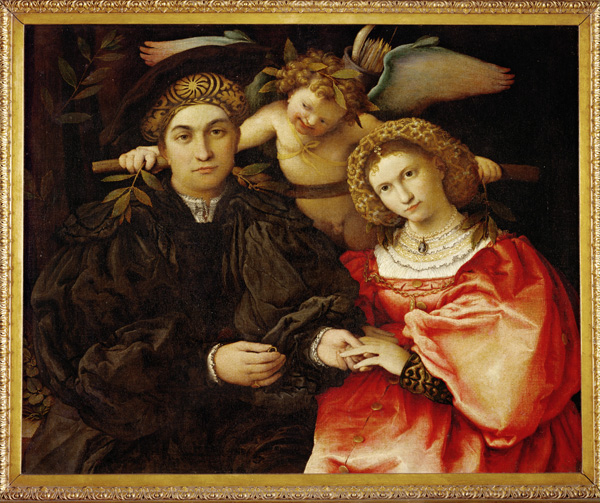
Lorenzo Lotto
Marsilio Cassotti and His Bride, Faustina, 1523
Oil on canvas, 71 x 84 cm (27 15/16 x 33 1/16 in.)
Museo del Prado, Madrid
Erich Lessing/Art Resource, NY
1) Lorenzo Lotto painted this marriage portrait of a couple from Bergamo, Marsilio Cassotti and Faustina Assonica, in 1523. The portrait uses Renaissance-era symbolism to express the goals and ideals of marriage in the sixteenth century. Bride and groom are wearing elegant and costly clothing to indicate their wealthy status. The bride wears several expensive pieces of jewelry, including a gold chain, draped over her shoulders, composed of many links, known as a “bond of love.” The concept of a happy union is conveyed in metaphorical terms by a smiling cupid (he is identified by the supply of arrows he carries in a basked strapped to his chest), who holds a yoke behind the couple and places a sprig of laurel—a symbol of virtue—on the shoulder of each.
This portrait uses Renaissance symbolism to make a statement about a happy and propitious marriage. What kinds of imagery would a modern bridal couple choose to indicate their goals and expectations of marriage?
![Attributed to Benvenuto Cellini<br /><i>Pietro Bembo, (1470–1547), Cardinal (1538), Venetian Philologist, Poet and Belletrist</i> [obverse]; <i>Pegasus on the Fountain Hippocrene</i>[reverse], 1537/1547<br />Bronze, diameter 5.5 cm (2 3/16 in.)<br />National Gallery of Art, Washington, DC, Samuel H. Kress Collection<br />Image courtesy of the Board of Trustees, National Gallery of Art</i>](http://italianrenaissanceresources.com/wp-content/uploads/2013/03/RP_271-1.jpg)
Attributed to Benvenuto Cellini
Pietro Bembo, (1470–1547), Cardinal (1538), Venetian Philologist, Poet and Belletrist [obverse]; Pegasus on the Fountain Hippocrene[reverse], 1537/1547
Bronze, diameter 5.5 cm (2 3/16 in.)
National Gallery of Art, Washington, DC, Samuel H. Kress Collection
Image courtesy of the Board of Trustees, National Gallery of Art
The medal’s obverse identifies Bembo by name and title. How does the imagery on the reverse communicate other aspects of his life and career?